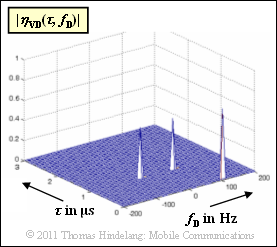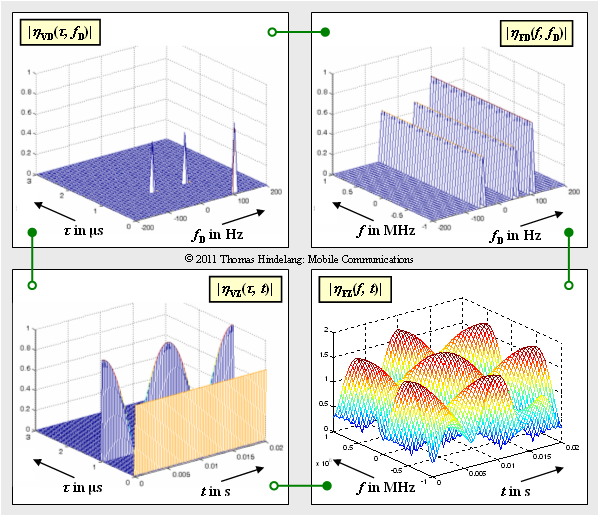Exercise 2.5: Scatter Function
For the mobile radio channel as a time-variant system, there are a total of four system functions that are linked with each other via the Fourier transform. With the nomenclature from our tutorial, these are:
- the time-variant impulse response $h(\tau, \hspace{0.05cm}t)$, which we also denote here as $\eta_{\rm VZ}(\tau,\hspace{0.05cm} t)$,
- the delay-Doppler function $\eta_{\rm VD}(\tau,\hspace{0.05cm} f_{\rm D})$,
- the frequency-Doppler function $\eta_{\rm FD}(f, \hspace{0.05cm}f_{\rm D})$,
- the time-variant transfer function $\eta_{\rm FZ}(f,\hspace{0.05cm}t)$ or $H(f, \hspace{0.05cm}t)$.
The four possible system functions are uniformly denoted by $\boldsymbol{\eta}_{12}$ .
- The first subindex is either a $\boldsymbol{\rm V}$ $($because of German $\rm V\hspace{-0.05cm}$erzögerung ⇒ delay time $\tau)$ or a $\boldsymbol{\rm F}$ $($frequency $f)$.
- Either a $\boldsymbol{\rm Z}$ $($because of German $\rm Z\hspace{-0.05cm}$eit ⇒ time $t)$ or a $\boldsymbol{\rm D}$ $($Doppler frequency $f_{\rm D})$ is possible as the second subindex.
The delay–Doppler function $\eta_{\rm VD}(\tau,\hspace{0.05cm} f_{\rm D})$ is shown in the plot:
- $$\eta_{\rm VD}(\tau, f_{\rm D}) \hspace{-0.1cm} \ = \ \hspace{-0.1cm} \frac{1}{\sqrt{2}} \cdot \delta (\tau) \cdot \delta (f_{\rm D} - 100\,{\rm Hz})-$$
- $$\hspace{1.75cm} \ - \ \hspace{-0.1cm} \frac{1}{2} \cdot \delta (\tau- 1\,{\rm \mu s}) \cdot \delta (f_{\rm D} - 50\,{\rm Hz})- \frac{1}{2} \cdot \delta (\tau- 1\,{\rm \mu s}) \cdot \delta (f_{\rm D} + 50\,{\rm Hz}) \hspace{0.05cm}.$$
In the literature, $\eta_{\rm VD}(\tau, \hspace{0.05cm}f_{\rm D})$ is often also called scatter function and denoted with $s(\tau, \hspace{0.05cm}f_{\rm D})$ .
In this task, the associated delay–time function $\eta_{\rm VZ}(\tau, \hspace{0.05cm}t)$ and the frequency–Doppler function $\eta_{\rm FD}(f, \hspace{0.05cm}f_{\rm D})$ are to be determined.
Notes:
- This task should clarify the subject matter of the chapter The GWSSUS Channel Model.
- The relationship between the individual system functions is given in the graph on the first page of this chapter.
- Note that the magnitude function $|\eta_{\rm VD}(\tau, \hspace{0.05cm} f_{\rm D})|$ is shown above, so negative weights of the Dirac functions cannot be recognized.
Questionnaire
Solution
- $$\eta_{\rm VZ}(\tau, \hspace{0.05cm} t) \hspace{0.2cm} \stackrel{t, \hspace{0.02cm}f_{\rm D}}{\circ\!\!-\!\!\!-\!\!\!-\!\!\bullet} \hspace{0.2cm} \eta_{\rm VD}(\tau, f_{\rm D})\hspace{0.05cm}.$$
- Accordingly, $\eta_{\rm VZ}(\tau,\hspace{0.05cm} t)=0$ for the values of $\tau$ that make $\eta_{\rm VD}(\tau, f_{\rm D})=0$.
- The solutions 1 and 2 are therefore correct: Only for $\tau = 0$ and $\tau = 1 \ \ \rm \mu s$ does the time variant impulse response have nonzero values.
(2) For the delay $\tau = 0$, the scatter function ($\eta_{\rm VD}$) consists of a single Dirac at $f_{\rm D} = 100 \ \rm Hz$.
- According to the second Fourier integral, the desired time-domain function satisfies:
- $$\eta_{\rm VZ}(\tau = 0, t) \hspace{-0.1cm} \ = \ \hspace{-0.1cm} \frac{1}{\sqrt{2}} \cdot \int\limits_{-\infty}^{+\infty} \delta (f_{\rm D} - 100\,{\rm Hz}) \cdot {\rm e}^{{\rm j}\hspace{0.05cm}\cdot\hspace{0.05cm} 2 \pi f_{\rm D} t}\hspace{0.15cm}{\rm d}f_{\rm D} =\frac{1}{\sqrt{2}} \cdot {\rm e}^{ {\rm j}\hspace{0.05cm}\cdot \hspace{0.05cm}2 \pi t \hspace{0.05cm}\cdot \hspace{0.05cm}100\,{\rm Hz}} .$$
- The correct solution is therefore solution 1.
(3) For the delay $\tau = 1 \ \ \rm µ s$ the delay–Doppler function consists of two Dirac functions at $±50 \ \rm Hz$, each with weight $-0.5$.
- The time function is then
- $$\eta_{\rm VZ}(\tau = 1\,{\rm \mu s}, t) = - \cos( 2 \pi t \cdot 50\,{\rm Hz})\hspace{0.05cm}.$$
- This function can be represented with $A = -1$ and $f_0 = 50 \ \rm Hz$ according to solution 2.
(4) The three Dirac functions $\eta_{\rm VD}(\tau, \hspace{0.05cm}f_{\rm D})$ are at the Doppler frequencies $+100 \ \rm Hz$, $+50 \ \rm Hz$ and $-50 \ \rm Hz$.
- For all other Doppler frequencies, therefore, we must have $\eta_{\rm FD}(f, \hspace{0.05cm}f_{\rm D}) \equiv 0$.
- Solution 2 is therefore correct.
(5) If one looks at the scatter function $\eta_{\rm VD}(\tau, \hspace{0.05cm}f_{\rm D})$ in the direction of the $\tau$–axis, there is one Dirac function at each of the Doppler frequencies $100 \ \rm Hz$ and $±50 \ \rm Hz$.
- Here, depending on $f$, complex exponential oscillations with constant magnitude result in each case (from which it follows that the solution 1 is correct):
- $$|\eta_{\rm FD}(f, \hspace{0.05cm}f_{\rm D} = 100\,{\rm Hz})| \hspace{-0.1cm} \ = \ \hspace{-0.1cm} {1}/{\sqrt{2}} = {\rm const.}$$
- $$| \eta_{\rm FD}(f, \hspace{0.05cm}f_{\rm D}= \pm 50\,{\rm Hz})| \hspace{-0.1cm} \ = \ \hspace{-0.1cm} 0.5 = {\rm const.}$$
(6) As can be seen from the given graph, solutions 2 and 3 are correct.
- The graph shows all system functions.
- The Fourier correspondences (shown in green) illustrate the relationships between these system functions.
Note:
Compare the time-variant transfer function $|\eta_{\rm FZ}(f, \hspace{0.05cm} t)|$ in the bottom right figure with the corresponding graph for Exercise 2.4:
- The respective magnitude functions differ significantly, although $|\eta_{\rm VZ}(\tau, t)|$ is the same in both cases.
- In Exercise 2.4, a cosine was implicitly assumed for $\eta_{\rm VZ}(\tau = 1 \ {\rm µ s}, t)$; here we have a negative cosine function.
- The (not explicitly) specified delay–Doppler function for Exercise 2.4 was
- $$\eta_{\rm VD}(\tau, f_{\rm D}) \hspace{-0.1cm} \ = \ \hspace{-0.1cm} \frac{1}{\sqrt{2}} \cdot \delta (\tau) \cdot \delta (f_{\rm D} - 100\,{\rm Hz})+$$
- $$\hspace{2cm}+\hspace{0.22cm}\frac{1}{2} \cdot \delta (\tau- 1\,{\rm \mu s}) \cdot \delta (f_{\rm D} - 50\,{\rm Hz})+ $$
- $$\hspace{2cm}+\hspace{0.22cm} \frac{1}{2} \cdot \delta (\tau- 1\,{\rm \mu s}) \cdot \delta (f_{\rm D} + 50\,{\rm Hz}) \hspace{0.05cm}.$$
- Comparison with the equation in this task shows that only the signs of the Diracs have changed at $\tau = 1 \ \rm µ s$.

